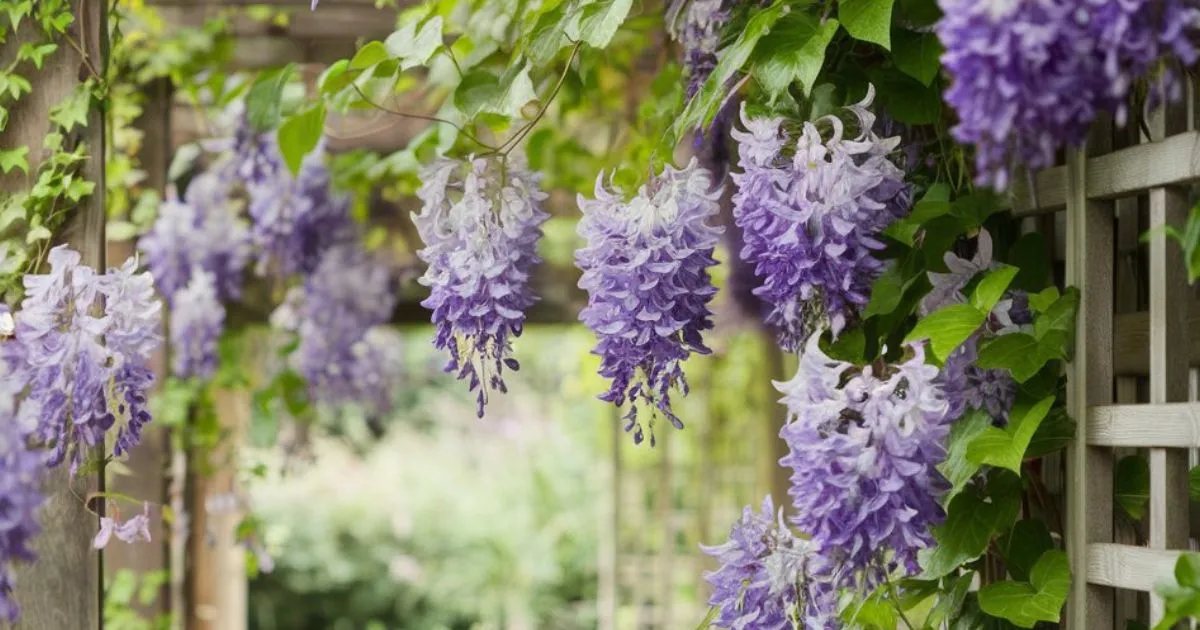Are you searching for the perfect way to transform your garden into a captivating, colorful escape? Purple climbing vines can be the answer you’re looking for. These versatile plants add beauty and create vertical interest in your garden, adding privacy and shade while attracting pollinators like bees, butterflies, and hummingbirds. In this guide, we’ll explore some of the best purple climbing vines, how to care for them, and how to use them to design a vibrant outdoor space you’ll love coming home to.
Table of Contents
Why Choose Purple Climbing Vines for Your Garden?
There’s something truly enchanting about a garden bursting with deep, rich purples. Purple climbing vines are ideal for those wanting to add elegance and depth. Whether you have a small balcony or a sprawling yard, these vines make excellent choices for bringing a burst of color and life into spaces large and small. Here’s why they’re worth considering:
- Elegant Appeal: Purple adds a touch of sophistication to your garden. Its rich tones stand out against lush greenery, offering a color that’s both calming and captivating.
- Enhanced Privacy: When grown along fences, walls, or trellises, climbing vines provide privacy by creating natural “walls” and shaded areas.
- Easy to Grow and Maintain: Many purple climbing vines are surprisingly low-maintenance, thriving in various climates and requiring minimal care once established.
- Attracts Pollinators: These vines offer nectar for pollinators like bees, butterflies, and hummingbirds, supporting biodiversity in your garden.
Let’s dive into some of the best purple climbing vines to consider for a vibrant and lively garden.
Top Purple Climbing Vines for Every Garden
Each of the vines below brings a unique charm to the garden, whether you’re looking for low-maintenance options, fast-growing choices, or something that blooms all season.
1. Wisteria (Wisteria sinensis)
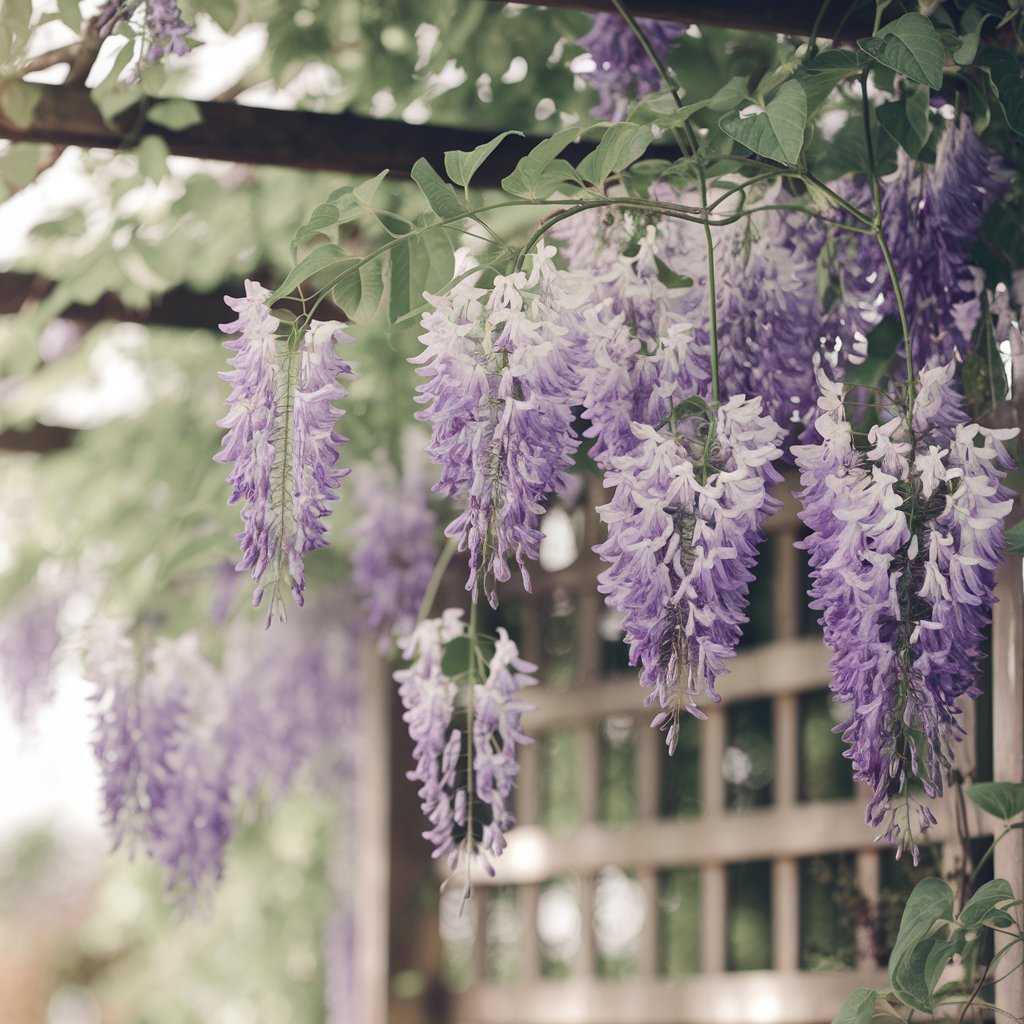
Wisteria is a beloved choice for gardeners who want to add drama with its drooping clusters of fragrant purple flowers.
- Description: Wisteria features eye-catching cascading blooms that bring a romantic feel to any garden.
- Growing Tips: This vine requires full sun to thrive and should be trained on a sturdy support structure due to its vigorous growth.
- Interesting Facts: Native to China, wisteria can live for decades and gets more beautiful with age, but be prepared for its rapid growth—it can climb structures or cover large areas quickly.
2. Clematis (Clematis viticella)
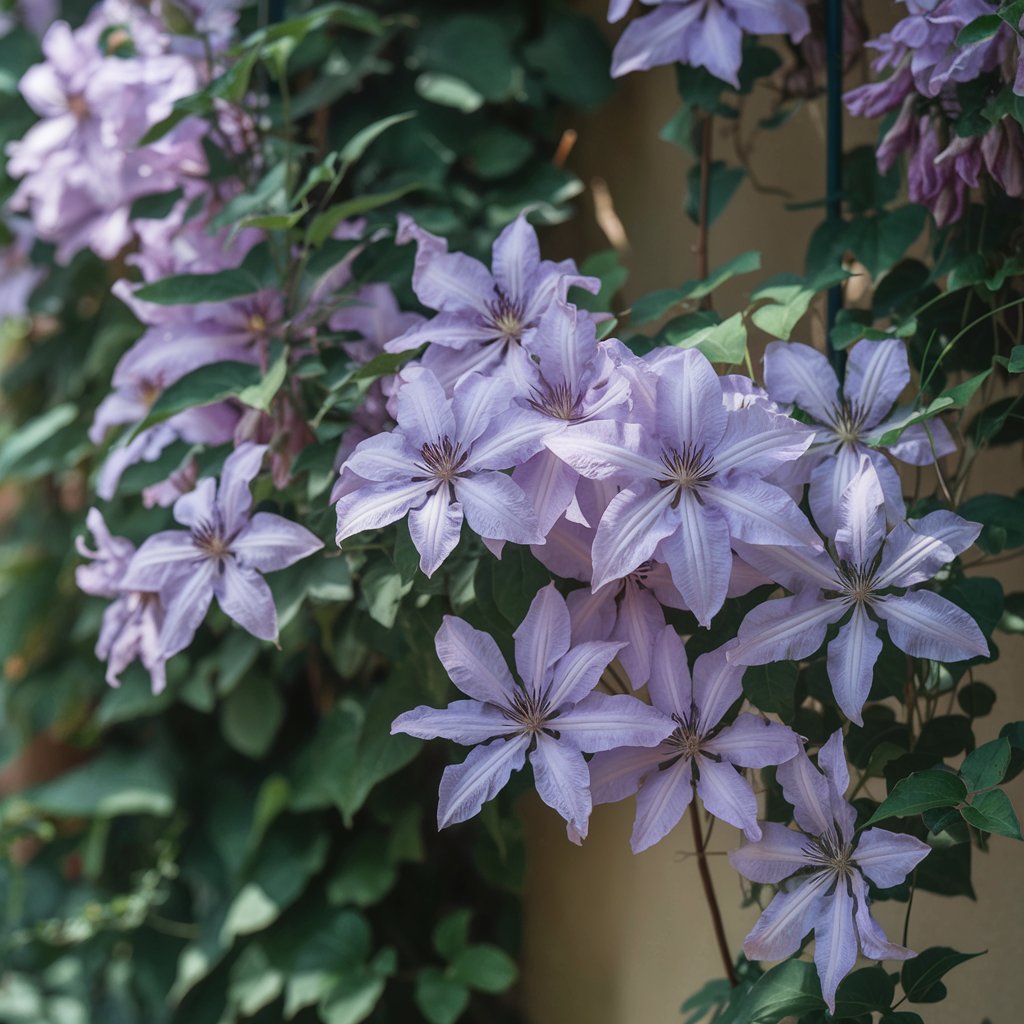
If you’re working with limited space, clematis might be the perfect purple vine for you. This compact, flowering vine offers delicate blooms and is ideal for smaller gardens.
- Description: Known for its dainty flowers, clematis offers lovely pops of purple on trellises, walls, or fences.
- Growing Tips: Clematis thrives in partial sun with well-drained soil. It’s relatively low-maintenance, making it perfect for beginners.
- Interesting Facts: A great choice for pairing with other climbing plants, clematis adds a subtle charm without overwhelming other plants in your garden.
3. Morning Glory (Ipomoea purpurea)
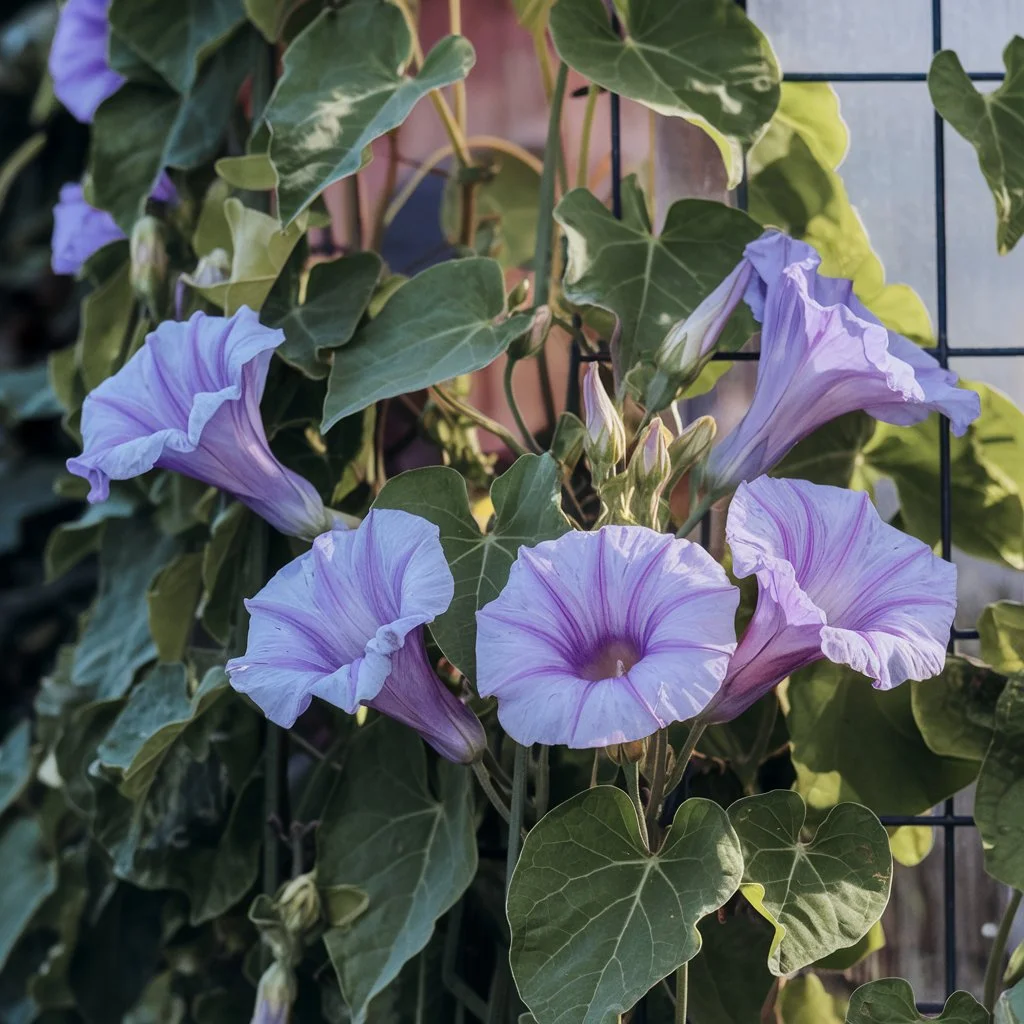
Morning Glory is a fast-growing annual vine that can quickly cover trellises, walls, and other garden structures with its vibrant, trumpet-shaped flowers.
- Description: This vine has heart-shaped leaves and blooms that open in the morning, often closing by afternoon.
- Growing Tips: Morning Glory loves full sun and needs regular watering. Its rapid growth makes it ideal for filling large spaces within a single season.
- Interesting Facts: Morning Glory’s blooms are short-lived, but the vine produces flowers continuously, ensuring a colorful display.
4. Purple Passionflower (Passiflora incarnate)
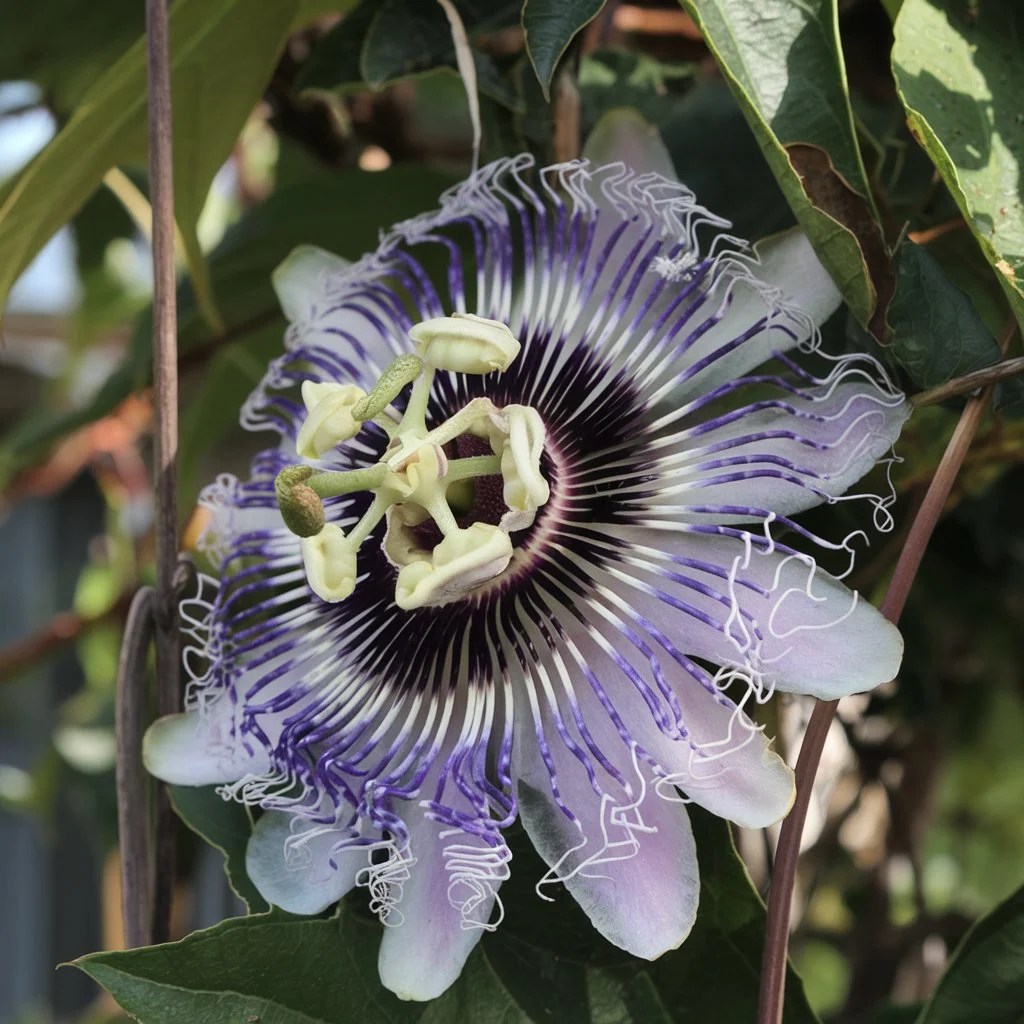
Passionflower is known for its unique, intricate blooms and is a fantastic addition if you’re looking for something a bit more exotic.
- Description: This tropical-looking flower features an otherworldly design, attracting attention and adding a unique touch to gardens.
- Growing Tips: Purple Passionflower does well in both full sun and partial shade, making it versatile for different garden setups.
- Interesting Facts: It attracts pollinators, and this vine also produces edible fruit—often used in jams or desserts.
Each of these vines offers something different in terms of appearance, maintenance, and growth patterns, so you can select the one that best fits your garden style.
How to Care for Purple Climbing Vines
Caring for purple climbing vines doesn’t have to be difficult. By understanding their soil, watering, and pruning needs, you’ll ensure they thrive year after year.
Soil and Watering Needs
Healthy soil is critical to the success of any plant. Here’s what you need to know for purple climbing vines:
- Soil Requirements: Most climbing vines prefer well-draining soil. Adding compost or organic matter can improve soil structure and provide essential nutrients.
- Watering Needs: These vines typically need moderate watering, especially in their early growth stages. Once established, they may tolerate periods of drought, but consistent moisture keeps them thriving.
Pruning and Training Vines
Proper pruning and training not only help control growth but encourage fuller blooms:
- Pruning Tips: For most vines, annual pruning is enough. Cut back dead or diseased growth and thin out any dense areas to improve air circulation.
- Training Techniques: Start training young vines to grow on trellises, walls, or fences by gently tying them to their support structures. As they grow, guide new shoots in the desired direction for an even spread.
Pest and Disease Prevention
Like any garden plants, climbing vines can be affected by pests and diseases:
- Common Pests: Aphids and spider mites are frequent pests. Using insecticidal soap or neem oil can help control these naturally.
- Disease Prevention: Some vines are susceptible to fungal diseases. Regular pruning and avoiding overhead watering reduce the risk of infection.
The Best Uses of Purple Climbing Vines in Garden Design
One of the best features of purple climbing vines is their versatility. You can use them in various ways to enhance your garden’s aesthetic and functionality.
Vertical Gardens and Privacy Walls
Use climbing vines to create natural walls that provide privacy and add visual interest. With strategic placement, these vines can transform bland spaces, making them more dynamic and secluded.
Pergolas, Arbors, and Trellises
Transform garden structures into shaded retreats by training vines over arbors and pergolas. The flowers create beautiful overhead blooms, offering refreshing shade as they mature.
Pairing Vines with Other Garden Plants
Mixing climbing vines with other plants enhances color contrast and depth. Consider pairing purple vines with white or yellow-flowering plants to make the colors pop.
Care Tips for Common Purple Climbing Vines
Here’s a quick reference table with care tips for popular purple climbing vines.
| Vine | Sun Requirements | Watering Needs | Soil Type | Special Notes |
|---|---|---|---|---|
| Wisteria | Full sun | Moderate | Well-drained, slightly acidic | Requires strong support structure |
| Clematis | Partial sun | Moderate | Well-drained, fertile | Compact, good for small spaces |
| Morning Glory | Full sun | High | Any soil, well-drained | Annual; fast-growing |
| Purple Passionflower | Full sun/partial shade | Moderate | Well-drained, loamy | Produces edible fruit |
Tips for Planting and Propagating Purple Climbing Vines
Planting and propagation can help your purple climbing vines flourish and create new growth every season.
- Planting Season: Spring is typically the best time for planting, as it allows vines to establish before the heat of summer.
- Propagating from Seeds and Cuttings: Start seeds indoors to give them a head start, or propagate from cuttings for faster growth.
- First-Year Care: New plants need extra attention, so water regularly and protect young vines from harsh winds or direct sunlight.
Frequently Asked Questions about Purple Climbing Vines
What are the easiest purple climbing vines to grow?
For beginners, clematis and morning glory are excellent options. Both are relatively low-maintenance and adapt well to different garden conditions.
Do purple climbing vines attract pollinators?
Yes, many purple climbing vines like wisteria and passionflower attract pollinators such as butterflies, bees, and hummingbirds, supporting a thriving garden ecosystem.
How fast do purple climbing vines grow?
Growth rates vary. Annuals like morning glory can cover large areas in a single season, while perennials like wisteria may take longer but offer longevity.
Can I grow purple climbing vines in containers?
Some varieties, like clematis, do well in containers. Just ensure the container is large enough to support the root system and has good drainage.
Conclusion: Creating a Vibrant, Purple Haven with Climbing Vines
Adding purple climbing vines to your garden can transform it into a place of beauty and serenity. Whether you’re covering a fence, creating a shaded seating area, or simply adding a touch of whimsy, these vines can elevate your garden design. Why not start with one or two varieties that suit your space and style? Embrace the elegance and allure of purple climbing vines, and watch as your garden comes to life.

